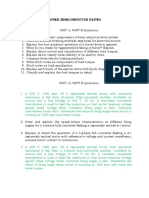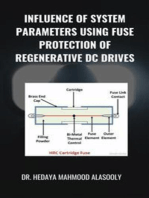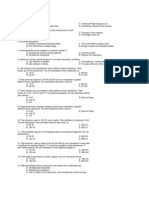Tutorial 1
Tutorial 1
Uploaded by
Ashutosh TomarOriginal Description:
Copyright
Available Formats
Share this document
Did you find this document useful?
Is this content inappropriate?
Report this DocumentCopyright:
Available Formats
Tutorial 1
Tutorial 1
Uploaded by
Ashutosh TomarCopyright:
Available Formats
Analysis and Control of Electric Drives
EE 324 Tutorial 1
1. A 220 V, 200 A, 800 rpm DC separately excited motor has an armature resistance of 0.06 Ω.
The motor armature is fed from a variable voltage source with an internal resistance of 0.04 Ω.
Calculate internal voltage of the variable voltage source when the motor is operating in
regenerative braking at 80% of the rated motor torque and 600 rpm.
2. A 220 V Dc series motor runs at 1000 rpm (clock wise) and takes an armature current of 100A
when driving a load with constant torque. Resistance of the armature and field windings are
0.05 Ω each. This series motor operated under dynamic braking at twice the rated torque and
800 rpm. Calculate the value of braking current and resistance. Assume linear magnetic circuit.
3. A Dc shunt motor has the armature resistance of 0.04 Ω and field winding resistance of 10 Ω.
Motor is coupled to an overhauling load with a torque of 400 NM. Following magnetization
curve was measured at 600 rpm.
Filed 2.5 5 7.5 10 12.5 15 17.5 20 22.5 25
Current(A)
Back emf 2.5 50 73.5 90 102.5 110 116 121 125 129
(V)
Motor is braked by self excited dynamic braking with a braking resistance of 1Ω. At what speed
motor will hold the load?
4. A 220 V, 970 rpm, 100 A DC separately excited motor has an armature resistance of 0.05 Ω. It
is braked by pluging from an initial speed of 1000 rpm. Calculate
(a) Resistance to be placed in armature circuit to limit braking current to twice the full load
value.
(b) Braking torque, and
(c) Torque when speed has fallen to zero.
5. A 400 V, star connected, 3 phase, 6-pole, 50 hz induction motor has following parameters
referred to the stator: Rs=Rr’ = 1Ω, Xs=Xr’=2Ω.
For regenerative braking operation of this motor determine:
(a) Maximum overhauling torque it can hold and range of speed for safe operation.
(b) Speed at which it will hold an overhauling load with a torque of 100 Nm.
(c) Maximum overhauling torque the motor can hold as a ratio of maximum overhauling torque
without capacitor if a capacitive reactance of 2 Ω is inserted in each phase of stator.
6. The motor ratings mentioned in the above problem is to be braked by plugging from its initial
full load speed of 950 rpm. Stator to rotor turns ratio is 2.3.
(a) Calculate the initial braking current and torque as a ratio of their full load values.
(b) What resistance must be inserter in rotor circuit to reduce the maximum braking current to
1.5 times full load current? What will be initial braking torque now?
7. A 440 V, 50 Hz, 6 pole, Y-connected wound rotor induction motor has following parameters
referred to stator:
Rs= 0.5 Ω, Rr’ = 0.4 Ω, Xs = Xr’= 1.2 Ω, Xm = 50 Ω
An external resistance is inserted into rotor circuit so that maximum torque is produced at S m =
2. The motor, which was initially operating on no-load is being braked by 1-phase AC dynamic
braking with three lead connection. Calculate the braking current and torque as a ratio of their
full load values for 950 rpm.
You might also like
- EMF Assignment1Document5 pagesEMF Assignment1Ahtasham ArshadNo ratings yet
- Draw No - MEG-2113-KYE-CS-301 - 275kV Single Line DiagramDocument1 pageDraw No - MEG-2113-KYE-CS-301 - 275kV Single Line DiagramMohamad HishamNo ratings yet
- Dcd-I HVDCDocument3 pagesDcd-I HVDCsatya_vanapalli3422No ratings yet
- Assisnment QuestionsDocument6 pagesAssisnment QuestionsVenkat ManiNo ratings yet
- Electric Motors DrivesDocument2 pagesElectric Motors Drivesprashant srivastavNo ratings yet
- ME (1) The Direct Current Motor Generator REPORT1Document7 pagesME (1) The Direct Current Motor Generator REPORT1Giorgia DalusungNo ratings yet
- Airplane Brushless Motor ChartDocument2 pagesAirplane Brushless Motor ChartOlavo PastoreNo ratings yet
- Problem SetDocument2 pagesProblem Setkushagra chitkaraNo ratings yet
- Assignment IDocument4 pagesAssignment Iamith gupta0% (1)
- Problem Set1 DDocument2 pagesProblem Set1 D21je0038No ratings yet
- Tutorial 1Document2 pagesTutorial 1anirbansingha345No ratings yet
- 2-Speed Control and Braking MethodsDocument2 pages2-Speed Control and Braking MethodsCharandeep TirkeyNo ratings yet
- ED Assignment 2Document2 pagesED Assignment 2sushant.sahayee20No ratings yet
- Narayana Engineering College::Gudur/Nellore: Converter Fed DC MotorsDocument7 pagesNarayana Engineering College::Gudur/Nellore: Converter Fed DC MotorsVempalle RafiNo ratings yet
- Assignment 1 DriveDocument3 pagesAssignment 1 DriveswamNo ratings yet
- IDA - QuesbankDocument10 pagesIDA - QuesbankKavitha KaviNo ratings yet
- Example DC Motor DrivesDocument2 pagesExample DC Motor DrivesSyam Kushaini100% (1)
- DC Motor Tutorial 4Document2 pagesDC Motor Tutorial 4Aravind VinasNo ratings yet
- PSDDocument4 pagesPSDyaswanthNo ratings yet
- ECE 424 - Assign4Document2 pagesECE 424 - Assign4Amos AtandiNo ratings yet
- Tutorial-I Converter Fed DC Motor Drive Problems 1Document10 pagesTutorial-I Converter Fed DC Motor Drive Problems 1siva kumarNo ratings yet
- Tutorial 1 & 2Document2 pagesTutorial 1 & 2lucasNo ratings yet
- Tut 3Document3 pagesTut 3mohanrajgupta1950% (2)
- ELL 332 Assignment No1Document1 pageELL 332 Assignment No1Kartik HansNo ratings yet
- ET Tut7 AUT2017-18 PDFDocument3 pagesET Tut7 AUT2017-18 PDFMoulindu KunduNo ratings yet
- Part BDocument10 pagesPart BVenkat ManiNo ratings yet
- r7410202 Power Semiconductor DrivesDocument4 pagesr7410202 Power Semiconductor Drivessriksjntu4508No ratings yet
- DC GeneratorDocument2 pagesDC GeneratorAravind Vinas100% (1)
- Tut 3 emDocument2 pagesTut 3 emBishal TiwariNo ratings yet
- EE664 Prob Set1Document3 pagesEE664 Prob Set1Shubham YadavNo ratings yet
- Department of Electrical Engineering, I.I.T. MandiDocument1 pageDepartment of Electrical Engineering, I.I.T. MandiKuldeepNo ratings yet
- Problems On AC Drives PDFDocument2 pagesProblems On AC Drives PDFAbbas NizamNo ratings yet
- PSD Subjective II Sem 2016-17Document7 pagesPSD Subjective II Sem 2016-17Saravanan T YNo ratings yet
- Tu 5Document2 pagesTu 5anup chauhanNo ratings yet
- WWW - Manaresults.Co - In: B.Tech III Year II Semester (R13) Supplementary Examinations December 2016Document2 pagesWWW - Manaresults.Co - In: B.Tech III Year II Semester (R13) Supplementary Examinations December 2016Kunte Vikas RaoNo ratings yet
- DCM QuestionsDocument2 pagesDCM Questionsljyandrew122122No ratings yet
- Department of Electrical Engineering Indian Institute of Technology, Roorkee Roorkee EE - 101: Electrical Science Tutorial Sheet - 09Document1 pageDepartment of Electrical Engineering Indian Institute of Technology, Roorkee Roorkee EE - 101: Electrical Science Tutorial Sheet - 09Bharat SinghNo ratings yet
- Answer Any Five Questions. The Figures in The Right-Hand Margin Indicate MarksDocument2 pagesAnswer Any Five Questions. The Figures in The Right-Hand Margin Indicate MarksSoubhagya Ranjan NayakNo ratings yet
- ET Tut7 AUT2017-18Document2 pagesET Tut7 AUT2017-18raviNo ratings yet
- Problems On DC Motor DrivesDocument2 pagesProblems On DC Motor Drivesvivek.2023ree07No ratings yet
- Assignment 3Document3 pagesAssignment 3yisakabera123No ratings yet
- Indian Institute of Engineering Science and Technology, Shibpur Department of Electrical EngineeringDocument4 pagesIndian Institute of Engineering Science and Technology, Shibpur Department of Electrical EngineeringKool PrashantNo ratings yet
- Last Date of Submission:07.05.2016Document2 pagesLast Date of Submission:07.05.2016zubbbuNo ratings yet
- DC MotorGeneratorDocument32 pagesDC MotorGeneratorna zafira100% (2)
- Tutorial EDDocument10 pagesTutorial EDPavan KhetrapalNo ratings yet
- Assignment (DC Motors and Measurement)Document1 pageAssignment (DC Motors and Measurement)RoronoaNo ratings yet
- Synchronous Machine ProblemsDocument5 pagesSynchronous Machine Problemsbhuvana71No ratings yet
- Asynchronous and Synchronous AssignmentDocument3 pagesAsynchronous and Synchronous AssignmentKaranNo ratings yet
- PSD Cluster456Document10 pagesPSD Cluster456Ramesh VajrapuNo ratings yet
- Tutorial 2Document2 pagesTutorial 2tanaya.s.gadkariNo ratings yet
- Practice ProblemsDocument4 pagesPractice Problemsdragon_warrior112456804No ratings yet
- Assignment-I FEDDocument2 pagesAssignment-I FEDHarish ChandraNo ratings yet
- 4-1 R05 Nov 2011Document99 pages4-1 R05 Nov 2011ladduNo ratings yet
- Training Machines2, Homework in Electrical MachinesDocument5 pagesTraining Machines2, Homework in Electrical MachinesNGOUNENo ratings yet
- EEE441Document2 pagesEEE441abcdefgNo ratings yet
- EEE 43 Final 2017Document3 pagesEEE 43 Final 2017Emman Joshua BustoNo ratings yet
- Test 15Document10 pagesTest 15James Laroda LaceaNo ratings yet
- Trabajo Máquinas C.C.Document1 pageTrabajo Máquinas C.C.dileconNo ratings yet
- Trabajo Máquinas C.C. PDFDocument1 pageTrabajo Máquinas C.C. PDFdileconNo ratings yet
- Eeng 445 Electrical Motors II CatsDocument2 pagesEeng 445 Electrical Motors II CatsMackdonald ShiwaniNo ratings yet
- Some Power Electronics Case Studies Using Matlab Simpowersystem BlocksetFrom EverandSome Power Electronics Case Studies Using Matlab Simpowersystem BlocksetNo ratings yet
- Influence of System Parameters Using Fuse Protection of Regenerative DC DrivesFrom EverandInfluence of System Parameters Using Fuse Protection of Regenerative DC DrivesNo ratings yet
- Tutorial 6Document4 pagesTutorial 6Ashutosh TomarNo ratings yet
- Tutorial 2Document3 pagesTutorial 2Ashutosh TomarNo ratings yet
- DC Motor Drives: MotorsDocument16 pagesDC Motor Drives: MotorsAshutosh TomarNo ratings yet
- Tutorial 4Document3 pagesTutorial 4Ashutosh TomarNo ratings yet
- Tutorial 9Document4 pagesTutorial 9Ashutosh TomarNo ratings yet
- Tutorial 1: EE-312 Physical Significance of Mathematical MethodsDocument2 pagesTutorial 1: EE-312 Physical Significance of Mathematical MethodsAshutosh TomarNo ratings yet
- Tutorial 4Document3 pagesTutorial 4Ashutosh TomarNo ratings yet
- Solution: Tutorial 1 EE-312 Physical Significance of Mathematical MethodsDocument2 pagesSolution: Tutorial 1 EE-312 Physical Significance of Mathematical MethodsAshutosh TomarNo ratings yet
- On 19Th MarchDocument125 pagesOn 19Th MarchAshutosh TomarNo ratings yet
- Design and Implementation of A Highly Efficient Three-Level T-Type Converter For Low-Voltage ApplicationsDocument9 pagesDesign and Implementation of A Highly Efficient Three-Level T-Type Converter For Low-Voltage ApplicationsAshutosh TomarNo ratings yet
- M49SP-2K DataSheetDocument2 pagesM49SP-2K DataSheetMarcos George0% (1)
- Pricelist Pats PompaDocument1 pagePricelist Pats PompaNugrohoAriePutrantoNo ratings yet
- Sew-Eurodrive, Inc.: MotorDocument1 pageSew-Eurodrive, Inc.: MotorcmaradiagaNo ratings yet
- Structure and Working Principle of DC Generator and AC GeneratorDocument14 pagesStructure and Working Principle of DC Generator and AC GeneratorZeti OzeiiNo ratings yet
- InductorsDocument22 pagesInductorsazafa netNo ratings yet
- 192 - EE8301, EE6401 Electrical Machines I - Question Bank 3Document15 pages192 - EE8301, EE6401 Electrical Machines I - Question Bank 3Kaleeswari SaraswathiNo ratings yet
- Fuzzy-Logic Based Speed Control of Induction Motor Considering Core Loss Into AccountDocument7 pagesFuzzy-Logic Based Speed Control of Induction Motor Considering Core Loss Into AccountJason CarrNo ratings yet
- Competitive Cross Reference: Power InductorsDocument1 pageCompetitive Cross Reference: Power Inductorskatie farrellNo ratings yet
- Induction MotorsDocument47 pagesInduction MotorsPurushothaman KannanNo ratings yet
- Electrical Machines: IES Electrical Engineering Topic Wise QuestionsDocument78 pagesElectrical Machines: IES Electrical Engineering Topic Wise QuestionsahmedNo ratings yet
- Quiz 10Document2 pagesQuiz 10John Paul GarciaNo ratings yet
- Synchronous Generator I PDFDocument38 pagesSynchronous Generator I PDFjcrodriguez8367% (3)
- Kings: College of Engineering Department of Electronics and Communication EngineeringDocument2 pagesKings: College of Engineering Department of Electronics and Communication Engineeringbalaer05No ratings yet
- Difference Between Single Phase and Three Phase Induction Motor Electrical AcademiaDocument6 pagesDifference Between Single Phase and Three Phase Induction Motor Electrical AcademiaRidwan ibn LuqmanNo ratings yet
- Motor Acdc 4 Preventive MaintenanceDocument20 pagesMotor Acdc 4 Preventive MaintenancelianaNo ratings yet
- Types of PMSMDocument2 pagesTypes of PMSMSaheb Ghosh0% (1)
- 300+ TOP D.C. GENERATORS Multiple Choice Questions and AnswersDocument32 pages300+ TOP D.C. GENERATORS Multiple Choice Questions and Answershem singhNo ratings yet
- DC MachineDocument20 pagesDC MachineTammanurRaviNo ratings yet
- Substation Transformer Impedance Worksheet ###: Impedance in Per UnitDocument1 pageSubstation Transformer Impedance Worksheet ###: Impedance in Per UnitromoNo ratings yet
- Basics and Eq CKT of Induction MotorDocument16 pagesBasics and Eq CKT of Induction MotorAshwini SinghNo ratings yet
- Synchronous Condenser PDFDocument3 pagesSynchronous Condenser PDFSharad Patel0% (1)
- BacksTab 03Document155 pagesBacksTab 03VaishnaviRaviNo ratings yet
- Failure Analysis Report: (Generation Company)Document13 pagesFailure Analysis Report: (Generation Company)johnlavuNo ratings yet
- HMWK5 SolutionsDocument4 pagesHMWK5 SolutionsWana BilaNo ratings yet
- Design 7 Induction MotorDocument7 pagesDesign 7 Induction MotorNoykols GRncNo ratings yet
- PDF Induction Machines Handbook Transients Control Principles Design and Testing 3Rd Edition Ion Boldea Author Ebook Full ChapterDocument54 pagesPDF Induction Machines Handbook Transients Control Principles Design and Testing 3Rd Edition Ion Boldea Author Ebook Full Chapterjimmie.powers966100% (6)
- Site Inspection and Test Record: 534/22/3 Alfanar Sec-Cta Of3 S/S 9015 S10348Document4 pagesSite Inspection and Test Record: 534/22/3 Alfanar Sec-Cta Of3 S/S 9015 S10348essam khalilNo ratings yet



































































































